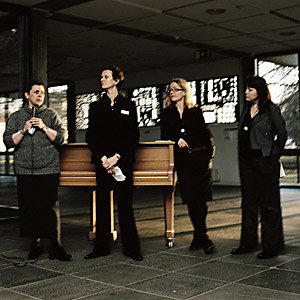Elisabet Apelmo and Marit Lindberg
dal 2/2/2007 al 17/3/2007
Segnalato da
2/2/2007
Elisabet Apelmo and Marit Lindberg
Landskrona Kunsthalle, Landskrona
Marked, unmarked. Video, sound and exercise

Marked, unmarked. Video, sound and exercise
Elisabet Apelmo and Marit Lindberg
Elisabet Apelmo uses photography, video, sound and drawing in her works to explore
power, identity, the body and sexuality. Apelmo also holds a master’s degree in
sociology. Marit Lindberg’s works in video are based on stories, collective memories
and language gaps. The point of intersection in the two artists’ work is the
absorption with narrative and the shift between the documentary and the fictional.
They also share an interest in women’s soccer, Apelmo from a sociological
perspective and Lindberg as the parent of a girl who is a serious player of the
game.
Marked, unmarked
Landskrona Konsthall was designed in 1963 by architects Sten Samuelsson and Fritz
Jaenecke. The austere architecture in concrete and glass is considered one of the
best examples of Swedish modernism. The park is present everywhere in the museum:
around the building, inside in the atrium and in between, captured in the
reflections in the glass. The park is part of the public urban space, but for whom
is it public and at what hours of the day? The resonant base of the work is men’s
violence against women, in both private and public settings. Cultural geographer
Birgitta Andersson describes the violence as a continuum from verbal insult to rape,
where the less serious offenses serve to remind the woman of the threat of rape. In
response to the threat of victimization, women calculate their risks to avoid
violence, which in turn leads to spatial limitations. The risk assessment is often
such an obvious part of womanhood that it is not verbalized. But the artists are not
intereste
d in reproducing the stereotypical picture of the frightened and defenseless woman.
Where power is exercised, there is always potential for resistance and the focus of
the exhibition is this power/counter power.
Sociologist Pierre Bourdieu believes that the female existence is constituted
through male superordination as a perceived object, an object for others to look at.
The negative collective expectations of women’s physical ability tends to become
part of the body, expressed as permanent states of affairs. Bourdieu discusses
sports as a means of changing these states. Intensive practice of sports “leads to a
profound transformation of the subjective and objective experience of the body.
[...] It [the body] is no longer merely a thing that is made to be looked at or
which one has to look at in order to prepare it to be looked at. Instead of being a
body for others it becomes a body for oneself; the passive body becomes an active
and acting body” writes Bourdieu. Through the practice of sports, the passive and
objectified woman becomes an active, and de facto stronger, subject. Sports may also
function as one form of resistance against traditional femininity, wherein the risk
of be
ing the victim of male violence seems to be an accepted ingredient.
Karate is a concrete form of resistance, a martial art of self-defense. Can soccer
be used as a more complex picture of resistance? Even though it is the most popular
sport among women in Sweden, women soccer players are paradoxically enough
considered unfeminine, mannish, or lesbian. The strength, speed, fearlessness and
aggression it takes to be a good soccer player do not coincide with either
traditional femininity or the image of woman as victim.
A group of women karateka, two women’s soccer teams, a male choir and two young
musicians from Landskrona are involved in the exhibition. Shadow pictures of the
women athletes in training are projected on the museum’s glass façade. The
singers in the male choir are dressed in sports jerseys. They represent the male
coaches, fathers, or boyfriends standing alongside the field.
Spelplan Landskrona Konsthall
Marked, unmarked is the first of three exhibitions in Spelplan Landskrona Konsthall,
a joint project of Kultur Skaring;ne and the municipality of Landskrona. A
catalogue documenting the working processes surrounding the exhibition will be
published in September 2007.
Landskrona Kunsthalle
Slottsgatan - Landskrona
Hours: Tuesday – Sunday 13-18, closed Mondays



